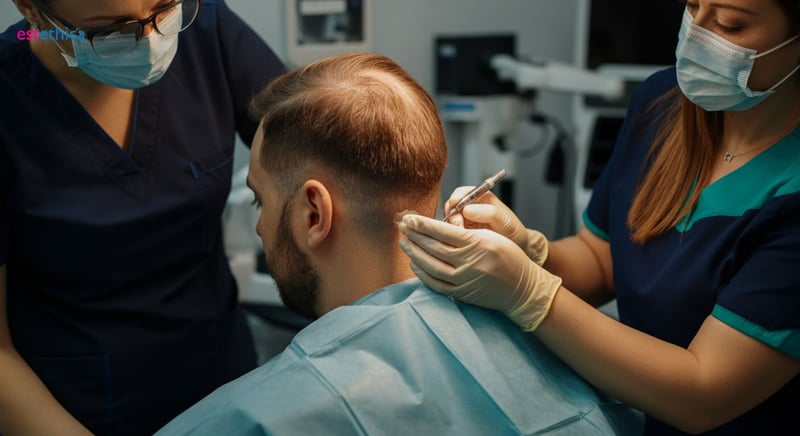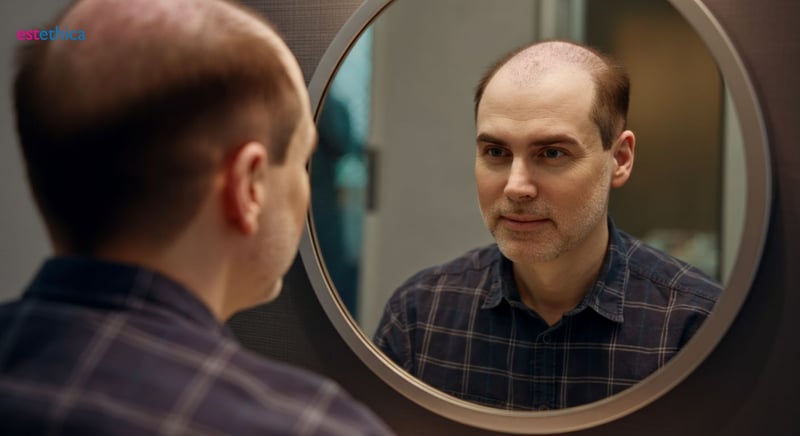Hair Transplant: Your Path to Natural Hair Restoration!
<p>Ready for a hair transformation? Discover estethica's advanced hair transplant solutions and start your journey to fuller, healthier hair!</p>
Unlock the potential of your hair with our comprehensive guide to hair transplantation. From understanding your hair loss to navigating the latest techniques, discover how a hair transplant can transform not just your look, but your confidence. Explore the modern solutions offered by estethica and embrace a path toward natural hair restoration.
Understanding Hair Loss: Is a Hair Transplant Right for You?
Determining Candidacy for Hair Restoration
Hair loss affects many, but not all cases require or benefit from a hair transplant. One key indicator is the pattern of hair loss. For instance, individuals with androgenetic alopecia, also known as male or female pattern baldness, are often good candidates because this condition typically follows a predictable pattern, allowing surgeons to strategically restore hair. Another factor is the stability of hair loss. If hair loss is still in an active phase, undergoing a hair transplant might not be the best immediate solution, as further loss could affect the overall outcome. Finally, general health plays a critical role; candidates should be in good overall health to ensure proper healing and graft acceptance. For example, conditions such as uncontrolled diabetes or certain autoimmune diseases could complicate the procedure and its results.
Key Considerations for Hair Transplant Eligibility
- Pattern of Hair Loss: Predictable patterns like androgenetic alopecia often respond well to surgical restoration.
- Stability of Hair Loss: Stable hair loss is preferable to active shedding to ensure lasting results from the hair transplant.
- Overall Health: Good health ensures optimal healing and graft survival.
The estethica Consultation Process
At estethica, the consultation for a hair restoration is a detailed process designed to assess individual needs and expectations. It begins with a thorough medical history review, including any medications and previous treatments. Next, a comprehensive scalp examination is performed to evaluate the extent and pattern of hair loss, as well as the condition of the scalp. For example, the density of donor hair is assessed to determine the viability of FUE hair transplant. The consultation also includes a discussion of the patient’s goals and expectations, ensuring alignment with what can realistically be achieved. For instance, a patient with significant hair loss may need to understand that the goal is to improve density and coverage rather than completely restore a full head of hair. The process ensures a personalized treatment plan tailored to each individual’s specific situation and desired outcomes, taking into account factors like hairline design and long-term hair loss management.
Steps in the estethica Consultation
- Medical History Review: Gathering essential health information for a safe and effective procedure.
- Scalp Examination: Assessing hair loss extent and scalp condition to plan the hair restoration.
- Goal Alignment: Discussing expectations to ensure realistic and satisfying results.

FUE vs. FUT: Exploring Modern Hair Transplant Techniques
Understanding FUE and FUT Methodologies
Follicular Unit Extraction (FUE) and Follicular Unit Transplantation (FUT) stand as the primary techniques in modern hair transplant. FUE involves extracting individual hair follicles directly from the scalp, which minimizes scarring and offers a quicker recovery time. FUT, on the other hand, involves removing a strip of scalp from which the hair follicles are then extracted; this method can yield a larger number of grafts in a single session, making it suitable for extensive hair loss. The choice between FUE and FUT often depends on the extent of hair loss, the patient's scalp characteristics, and their personal preferences regarding scarring and recovery. For example, someone with a tight scalp might benefit more from FUE, while someone needing a large number of grafts might opt for FUT. Regardless of the method, the goal is to restore hair in a way that looks natural and blends seamlessly with the existing hair.
Key Differences Between FUE and FUT
- Scarring: FUE leaves tiny, almost invisible scars, while FUT results in a single, linear scar.
- Graft Quantity: FUT can sometimes yield a higher number of grafts in one session compared to FUE.
- Recovery Time: FUE generally offers a quicker recovery period than FUT.
The estethica Approach to FUE and FUT
At estethica, both FUE and FUT techniques are conducted with a focus on precision and artistry, ensuring that each patient receives the most appropriate and effective treatment. The surgeons at estethica carefully assess each patient to determine which method aligns best with their specific hair loss pattern, hair characteristics, and desired outcomes. For instance, patients seeking to avoid a linear scar might prefer FUE, while those with extensive baldness may find FUT more suited to their needs. The clinic employs state-of-the-art technology and techniques, such as micro-surgical instruments and precise graft placement methods, to maximize graft survival and achieve natural-looking results. This includes careful attention to hairline design and hair density distribution to ensure that the transplanted hair blends seamlessly with the existing hair. Every step of the process is tailored to meet the individual needs of the patient, from pre-operative planning to post-operative care, ensuring a smooth and successful hair restoration journey.
The Process for Selecting the Right Technique
- Comprehensive Evaluation: Assessing the patient's hair loss pattern and scalp condition.
- Personalized Recommendation: Suggesting either FUE or FUT based on individual needs and preferences.
- Advanced Techniques: Utilizing state-of-the-art technology for optimal graft survival and natural results.

Does Hair Transplant Work? Realistic Expectations and Results
Defining Hair Transplant Success Rates
The success of a hair transplant is multifaceted, extending beyond mere hair growth to encompass patient satisfaction and natural appearance. While many patients experience significant hair regrowth, results can vary based on factors such as the surgeon's skill, the quality of the donor hair, and the individual's healing capabilities. One crucial aspect is the survival rate of transplanted follicles; generally, a reputable clinic aims for a survival rate above 90%. For instance, a patient with thick, healthy donor hair and a skilled surgical team can expect excellent results, whereas someone with poor donor hair quality may have more modest outcomes. Therefore, setting realistic expectations during the initial consultation is essential.
Key Factors Influencing Hair Transplant Outcomes
- Surgeon's Expertise: Skilled surgeons ensure precise graft placement and minimal trauma to hair follicles.
- Donor Hair Quality: Healthy and dense donor hair yields better growth and coverage.
- Individual Healing: The body's ability to heal and accept grafts affects the overall success.
Maximizing Durability Through Expert Aftercare
The longevity of a hair transplant heavily relies on diligent post-operative care and adherence to the clinic's guidelines. Proper care ensures that the transplanted follicles establish themselves effectively and continue to thrive. This includes avoiding strenuous activities, protecting the scalp from sun exposure, and using recommended hair care products. Additionally, some patients may benefit from treatments like DHT blockers, which help prevent further hair loss. For example, consistent use of prescribed medications and regular follow-up appointments can significantly enhance the durability of the results. At estethica, patients receive detailed aftercare instructions and ongoing support, ensuring they are well-equipped to maintain their transplanted hair for years to come.
Essential Steps for Ensuring Lasting Results
- Follow Post-Op Instructions: Adhering to the clinic's care guidelines protects the new grafts and promotes healing.
- Protect Scalp from Sun: Shielding the scalp from UV rays prevents damage to the transplanted follicles.
- Consider DHT Blockers: Using prescribed medications helps to slow down future hair loss.

Beyond the Procedure: Comprehensive Hair Loss Treatment Options
Exploring Non-Surgical Hair Loss Solutions at estethica
Beyond surgical options like hair transplant, estethica offers a range of non-surgical treatments designed to combat hair loss and promote scalp health. Platelet-Rich Plasma (PRP) therapy, for example, uses the patient's own blood to stimulate hair follicles, encouraging growth and increasing hair density. Additionally, mesotherapy involves injecting a customized blend of vitamins, minerals, and amino acids directly into the scalp to nourish hair follicles and improve circulation. These treatments can be particularly beneficial for those in the early stages of hair loss or as a complementary approach to hair restoration surgery, enhancing overall results. At estethica, the approach to managing hair loss is holistic, ensuring each patient receives a tailored plan to address their unique needs and goals.
Benefits of estethica's Non-Surgical Treatments
- PRP Therapy: Stimulates hair follicles using the patient's own blood for increased hair density..
- Mesotherapy: Delivers essential nutrients directly to the scalp to improve hair health.
- Complementary Care: Enhances the results of hair transplant procedures, promoting overall hair vitality.
How estethica Integrates Therapies for Comprehensive Hair Restoration
estethica takes a comprehensive approach to hair restoration by integrating various therapies to optimize results and patient satisfaction. The process begins with a detailed scalp analysis to determine the underlying causes of hair loss and identify the most suitable treatment options. For instance, a patient undergoing a FUE hair transplant might also receive PRP therapy to promote faster healing and enhance the growth of transplanted follicles. The clinic also offers continuous support and monitoring, adjusting treatment plans as needed to ensure the best possible outcome. This holistic approach not only addresses the immediate concerns of hair loss but also focuses on long-term hair health, ensuring lasting and natural-looking results. Patients at estethica benefit from a combination of advanced surgical techniques and innovative non-surgical treatments, all tailored to their individual needs.
estethica's Integrated Treatment Planning Process
- Scalp Analysis: Detailed assessment to identify the causes of hair loss and determine appropriate treatments.
- Therapy Integration: Combining surgical and non-surgical methods, such as FUE hair transplant and PRP, for optimal results.
- Ongoing Support: Continuous monitoring and adjustments to treatment plans to ensure long-term hair health.
Seasonal Hair Transplant Care: What You Need to Know
Navigating Summer Recovery After a Hair Transplant
Undergoing a hair transplant requires careful attention, especially during the summer months. Increased sun exposure, higher temperatures, and outdoor activities can pose unique challenges to the healing process. Protecting the newly transplanted area from direct sunlight is crucial, as sunburn can damage the delicate follicles and impede growth. Wearing a wide-brimmed hat or using a gentle, doctor-approved sunscreen are essential precautions. Hydration also plays a significant role; drinking plenty of water helps maintain scalp health and supports the recovery of transplanted hair. Engaging in water sports or heavy exercise should be avoided in the initial weeks following the procedure to prevent infection and physical trauma to the grafts. Adjusting lifestyle habits during the summer can significantly impact the success and longevity of the hair restoration.
Essential Summer Aftercare Tips
- Sun Protection: Shield the scalp with hats or doctor-approved sunscreen to prevent sunburn.
- Hydration: Drink plenty of water to maintain scalp health and support hair growth.
- Avoid Strenuous Activities: Refrain from heavy exercise and water sports to protect grafts.
Optimal Timing for a Hair Transplant
While a hair transplant can be performed at any time of the year, certain seasons may offer advantages over others. Many patients find that undergoing the procedure during the fall or winter allows for a more comfortable recovery. Lower temperatures and reduced sun exposure can minimize the risk of complications and provide a more conducive environment for healing. Additionally, the need to wear hats and protective clothing during these seasons naturally aids in shielding the scalp. For example, planning a FUE hair transplant in late autumn means the initial recovery phase occurs during milder weather, reducing the challenges associated with summer heat and UV radiation. Ultimately, the best time for a hair restoration is a personal decision that considers individual lifestyle, climate, and the ability to adhere to post-operative care guidelines.
Seasonal Timing Strategies for Hair Restoration
- Consider Fall or Winter: Lower temperatures and less sun can ease recovery.
- Utilize Protective Clothing: Hats and scarves naturally shield the scalp in cooler months.
- Personal Lifestyle Factors: Evaluate your ability to manage post-op care based on your schedule and climate.
Choosing estethica: Your Trusted Hair Transplant Partner
Advanced Facilities and Skilled Practitioners at estethica
When considering a hair transplant, the expertise of the medical team and the quality of the facilities play pivotal roles in achieving successful outcomes. estethica distinguishes itself through its state-of-the-art clinics, equipped with the latest technology to facilitate procedures such as FUE hair transplant with precision and care. The practitioners at estethica are highly skilled and experienced in various hair restoration techniques, ensuring patients receive treatments tailored to their specific needs. For instance, the surgical team's proficiency in hairline design and graft placement ensures natural-looking results that blend seamlessly with the patient's existing hair. Furthermore, estethica’s commitment to ongoing training and education keeps its staff at the forefront of advancements in hair restoration, providing patients with the best possible care.
Key Advantages of Choosing estethica
- Cutting-Edge Facilities: Equipped with the latest technology for precise and effective hair restoration treatments.
- Skilled Practitioners: Experienced surgeons and medical staff dedicated to personalized patient care.
- Commitment to Innovation: Continuous training and adoption of the latest advancements in hair loss treatment.
Patient-Centered Care and Support at estethica
estethica places a strong emphasis on patient-centered care, ensuring that each individual feels supported and well-informed throughout their hair restoration journey. From the initial consultation to post-operative care, the clinic prioritizes clear communication, personalized treatment plans, and a comfortable environment. For example, patients receive detailed pre-operative instructions and realistic expectations about the procedure and its outcomes. The medical team is always available to address any concerns or questions, providing reassurance and guidance at every step. estethica also offers comprehensive aftercare support, including follow-up appointments and access to specialized products that promote healing and hair growth. This holistic approach ensures that patients not only achieve the desired aesthetic results but also have a positive and stress-free experience throughout their hair transplant transformation.
estethica's Commitment to Patient Satisfaction
- Personalized Treatment Plans: Tailored to individual needs and expectations for optimal results.
- Clear Communication: Ensuring patients are well-informed and comfortable throughout the process.
- Comprehensive Aftercare: Providing ongoing support and guidance for long-term success.
Precision FUE and FUT Hair Transplants for Natural-Looking Restoration
Personalized Hair Restoration Plans Supported by Continuous Patient Care
Frequently Asked Questions
Who is an ideal candidate for a hair transplant?
What are the main differences between FUE and FUT hair transplant techniques?
How can I ensure the longevity of my hair transplant results?
What non-surgical options are available for hair loss treatment?
Achieve your aesthetic goals with estethica's personalized treatments and expert care.
📞 Schedule Your Free Consultation!